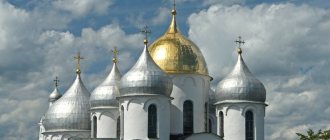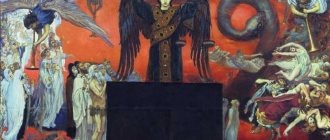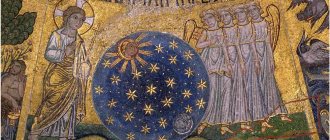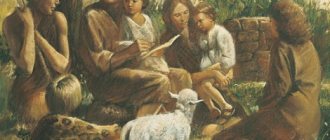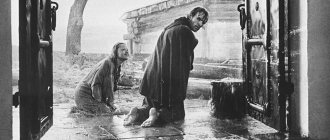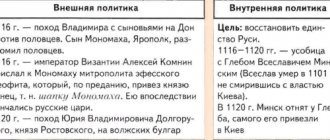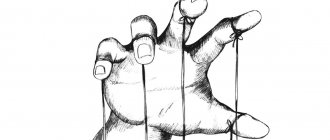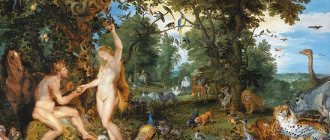Contents of the article:
- Michelangelo's painting "The Creation of Adam"
- How did Michelangelo fulfill the order of Pope Julius II?
- Where is the painting?
- What does "Creation of Adam" mean?
- The Sistine Chapel as a symbol of power
- Video: what else could Michelangelo’s creation mean?
In the book of Genesis, the Pentateuch of Moses sets forth the “theory” of God’s creation on Earth of the first man in His image and likeness. In the work of the famous Italian medieval artist Michelangelo, “The Creation of Adam,” this biblical story was used.
Background
Michelangelo is a famous painter and sculptor of the Renaissance. He lived a long and fruitful life. Born in 1475, already in the late 80s of the 15th century he began to study sculpture and fine art, and in the early 90s he created his first independent works. Even in these youthful works (the author is 15-17 years old), the makings of a future genius are noticeable. By the beginning of the 16th century, Michelangelo was already a fairly famous sculptor.
In 1505, the Pope invited him to create his own tomb, work on which lasted almost 40 years. But Michelangelo completed the painting of the vaults of the Sistine Chapel, which was commissioned by the same Julius II, in record time. It took him only 4 years to create dozens of frescoes with a total area of 600 m², which depict more than 300 figures. The fresco “The Creation of Adam” is one of the central ones in the entire composition.
Art critics note that Michelangelo took on painting the vaults with great reluctance. He proposed entrusting this matter to Raphael, but Julius II was adamant. Gradually, the artist became captivated by the work, and a masterpiece of monumental art was created.
The Sistine Chapel
The chapel building was built at the end of the 15th century by order of Pope Sixtus IV. Today it is one of the most important places in the Catholic world. It is in this building that the conclave of archbishops and cardinals meets to choose a new pope.
According to the idea of Sixtus IV, the chapel was supposed to resemble a fortress in appearance, symbolizing the impregnable center, the heart of the Catholic Church, and with its interior decoration to demonstrate the power of the Pope.
The building was built by the architect from Florence Giorgio de Dolci, and Botticelli, Rosselli, Perugino, Michelangelo and other famous artists of that time were engaged in painting and decorating the interior. The beauty and grandeur of biblical characters captivates the Sistine Chapel at first sight. “The Creation of Adam” is a fresco that occupies one of the central places in the painting, and is also one of the most expressive.
Vaults of the Sistine Chapel
On the ceiling of the chapel, Michelangelo created a grandiose ensemble, in the center of which are 9 scenes from the Old Testament. The first plot is “The separation of light from darkness”, the last one is “The Drunkenness of Noah”. The central place in the composition is occupied by the frescoes “The Creation of Adam”, “The Creation of Eve” and “The Fall”.
Along the perimeter of the frescoes of the central field, figures of young men and girls, prophets and sibyls are depicted, and the sides of the vault are painted with scenes from the Old Testament and represent the predecessors of Jesus Christ.
When Michelangelo began painting, he had neither knowledge nor experience in making frescoes. Specialists from Florence were invited to help him. But very soon the sculptor surpassed them in technique. Having driven away his assistants, he single-handedly completed the painting of the huge ceiling.
The grand opening of the ceiling of the Sistine Chapel was timed to coincide with All Saints' Day in October 1512. The first spectators were struck by the beauty and titanism of the images, the colossal size of the painting, distinguished by the unity of the plot. However, five centuries later this work continues to fascinate and delight.
How did Michelangelo fulfill the order of Pope Julius II?
The process of work was not at all easy for the artist in every sense.
Being generally more committed to the art of sculpture, Michelangelo was by no means eager to paint frescoes on the ceiling of the temple. He did not have such experience, and he received this specific order from the pope as a result of the intrigues of his ill-wishers.
Initially, Buanarotti asked familiar artists to help him master a new style of painting, but he quickly understood everything and refused their services, preferring to work alone. True, two assistants worked with him, one of whom mixed the paints, and the other covered the surface with lime, on which the master subsequently applied his brilliant strokes.
By the way, it was not at all easy to do this psychologically and even purely technically, since the specifics of this type of art did not allow corrections and amendments. I had to work straight away. Here the artist was helped by the talent of the sculptor and the “volumetric vision” of the future image, he even felt a taste for a new business.
True, after its completion, it took me a long time to come to my senses after constantly seeing the paintings from bottom to top, since I had to work lying down. For some time he even read books only in this position.
"The Creation of Adam" (Michelangelo). Description
The plot was taken from the Old Testament. The Bible says that God created man in his own image and likeness. The image can be divided into 2 parts. The Lord is placed at the top and to the right. He appears in the form of a gray-haired, but full of physical strength old man. He is surrounded by a host of angels. Red drapes complete the look. They enhance the impression, conveying a feeling of energy and strength.
Below and to the left is the figure of Adam. This is a wonderful young man. His strength has not yet been awakened; he reaches out to God with a weak hand. The right hand of the Lord is about to touch it and transfer life energy to the person. When the two hands touch, the act of creation is complete.
Notes[ | ]
- ↑ 1 2 Meshberger, Frank Lynn.
An Interpretation of Michelangelo's Creation of Adam Based on Neuroanatomy (English) // JAMA: journal. - 1990. - 10 October (vol. 264, no. 14). - P. 1837-1841. - doi:10.1001/jama.1990.03450140059034. - PMID 2205727. Pdf. Excerpt on Mental Health & Illness.com. Retrieved 21 September 2010. - ↑ 1 2 Rachel Becker.
Does the Michelangelo painting in the Westworld finale really show a brain — or is it a uterus? (English). The Verge (6 December 2016). Date accessed: December 15, 2021. - Fields, R. Douglas
Michelangelo's secret message in the Sistine Chapel: A juxtaposition of God and the human brain
(undefined)
.
Scientific American
(May 27, 2010). Date accessed: June 9, 2021.
Features of the painting
The fresco "The Creation of Adam" stands out among others created by Michelangelo. It was probably this story that particularly excited him. It is noteworthy that it does not depict the physical creation of man, but the transfer of life energy to him - the soul, the spark of God. The artist managed to show the dynamics and drama of the scene.
Art critics note that Michelangelo’s Adam reaches out with his hand not only to God, but also to Eve. She has not yet been born, the Almighty covers her with his left hand.
Until recently, Michelangelo was considered a poor colorist, noting that the images he created were more reminiscent of painted statues. However, restoration work made it possible to restore the original color of the frescoes. For the "Creation of Adam" scene, rich tones of various shades were used. In terms of painting technique, this work can be placed on a par with those created by his predecessors Michelangelo, Giotto and Masaccio.
So did God create man or create him?
Igor Bekshaev, March 5, 2021, 09:46 — REGNUM It is quite difficult to present the topic of God’s creation of man within the framework of one article. But let's try to briefly note the most obvious. According to the general opinion, and there are no exceptions here or they are so rare that they have been successfully forgotten, it is believed that in the second chapter of the Book of Genesis there is a “more detailed” story about the creation of man with a preliminary repetition of what was said earlier. This is how it reads in the Synodal Translation:
Michelangelo. Creation of Adam. Around 1511
“So are the heavens and the earth and all their hosts complete. And God finished on the seventh day His work that He had done, and He rested on the seventh day from all His work that He had done. And God blessed the seventh day and sanctified it, for on it He rested from all His works, which God had created and created. This is the origin of the heavens and the earth at their creation, at the time when the Lord God created the earth and the sky, and every bush of the field that was not yet on the earth, and every grass of the field that had not yet grown, for the Lord God did not send rain to the ground, and there was no man to till the ground, but steam rose from the ground and watered the whole face of the earth. And the Lord God formed man from the dust of the ground, and breathed into his nostrils the breath of life, and man became a living soul. And the Lord God planted a paradise in Eden in the east, and there he placed the man whom he had created.”
Of course, this is a completely different story, and there is nothing at all about the creation of man. Here it is said about the “creation” of man, and the verb used is appropriate. Even the Synodal translation conveys this difference, which is not necessary for it at all. It is interesting that some literalists (“modernists”), because of the verb “created” used here, conclude that the writer has changed. Or, as they report, the “Yahwist” writer allegedly replaced the “Elohist” writer at the table. Nothing else comes to mind, this is their dominant theory. But other literalists (“spiritual” ones) immediately forget that they are literalists and prefer not to notice such little things at all; the “letters” are immediately covered with a veil of fog.
Jan Brueghel the Younger. Adam and Eve in Paradise. 1618
Yes, things are different in the second chapter of Genesis. And the verbs are completely different, and God is no longer Elohim, but Yahweh (if we use the clumsy traditional transcription). The story is not at all similar to the previous one. However, it was not the “writer” who “changed” here, but his story took on a different character, without becoming “more spiritual”, and did not acquire a “spiritual plus”, as some of the literalists manage to guess. The writer did not pump himself up with a higher degree of “spirituality,” of course. The topic became more complex, and it was necessary to present it much more precisely, trying to use metaphors that even distant descendants could recognize if they did not count flies on the ceiling instead of trying to understand.
We will omit almost the entire evidence base here, because this has already been said before, and it will require a heavy load of the text by checking the translation with the original, but we will repeat the obvious. That man here, firstly, is not created, but created, the wife is not taken from the man, but is brought to him, being also not “created”, but formed. A careful reading of the Hebrew text makes it possible to understand that we are talking about a new quality of the previously created man, about the awakening in him of that degree of reason that allows him to define himself in the world in a completely new way.
Man is introduced into paradise, as it is said, and first comes the “seventh day” in divine employment, where creation ends and the path to perfection in the own freedom of the created man begins. The new world of man looks like this: “And God blessed the seventh day and sanctified it, for on it he rested from all His works, which God created and created (literally: created for the purpose of completion)... A river came out of Eden to irrigate paradise; and then divided into four rivers. The name of one is Pison: it flows around the whole land of Havilah, where there is gold; and the gold of that land is good; there is bdellium and onyx stone. The name of the second river is Gihon: it flows around the entire land of Cush. The name of the third river is Hiddekel: it flows before Assyria. The fourth river is the Euphrates. And the Lord God took the man and put him in the Garden of Eden to cultivate it and keep it.”
Lucas Cranach. Adam and Eve in the Garden of Eden. 1530
The attitude of everything that begins from here as to what happens on the “seventh day”, which, in fact, is literally discussed in the text, helps to read everything that follows correctly. So, Eden, the land of human habitation or simply the ecumene, was watered by a river. Many versions have been expressed about the “paradise rivers” over hundreds of years, they are unsatisfactory, because all these “studies” understand “division” too indiscriminately, believing that this word describes the division of the river into branches. But in the original there is no “division into four rivers,” it literally says “according to four main ones.” And if you leave the literalism alone and tune in to understanding, then, after reading the text a little further, it becomes clear why it is not the river that is divided, of course, but Eden (both in Hebrew are masculine), that is, the ecumene: “To Eber were born two sons; the name of one is Peleg, because in his days the land was divided; His brother's name is Joktan."
The division of the earth is described in the tenth chapter of Genesis. Families and tribes who shared the land settled along major rivers. These are the Nile, Jordan, Tigris and Euphrates - they are listed here. The second chapter describes the geographical location of Eden-ecumene with reference to subsequent events in time. Thus, from the example of even this small fragment, one can see that understanding such a complex text as the first chapters of the Book of Genesis requires careful and, in a sense, “literal” following of thought. However, “letters” should be used not for the sake of their very existence in isolation from thought, but with benefit - for the sake of understanding what is written.
So, in the second chapter of the Book of Genesis it is said about the awakening in man of a mind tuned to distinguish between good and evil. Few attentive theologians talk about man in the image, and “he is created” (“made”, to be more precise) - in his likeness. To a man removed from the animal state, God brings a wife, formed, as it is written and literally believed to be, from a “rib.” There is not even a metaphor here or it is superficial. Adam's wife is brought from the other "half", part of created humanity. No bone transplant operations are performed here. The word translated and usually understood as “rib” has another meaning - “part, half”, so we will leave the tales about hocus-pocus with rib surgery to the “weak” with their idea of God as such a “powerful” wizard that knows how to make a woman from a rib.
Creation of Eve. Mosaic
We see a short and succinct story about how reason began to awaken in people and awareness of their difference from the animal world. Adam began to name everything around him, that is, he acquired speech, the world ceased to just flow past him passively and contemplatively, he began to be known. At the end of this paradise and at the beginning of the tragic story that follows it, humanity will fall into the “fall”, which will destroy its entire prospect of smooth development. This question is one of the most difficult, the complexity is added to by our talkative preachers, who present everything in the form of a fairy tale about a white bull, without even trying to translate the meaning hidden in metaphors to the proper level of understanding.
The liturgical readings combine several different stories - starting with the bringing of a wife to Adam, then the Fall and, finally, Adam naming his wife Eve - into one large reading, apparently based on the consideration that everything about the woman must be done at once, without delay. We will separate them, highlighting only the topic of “the Fall” tomorrow.
